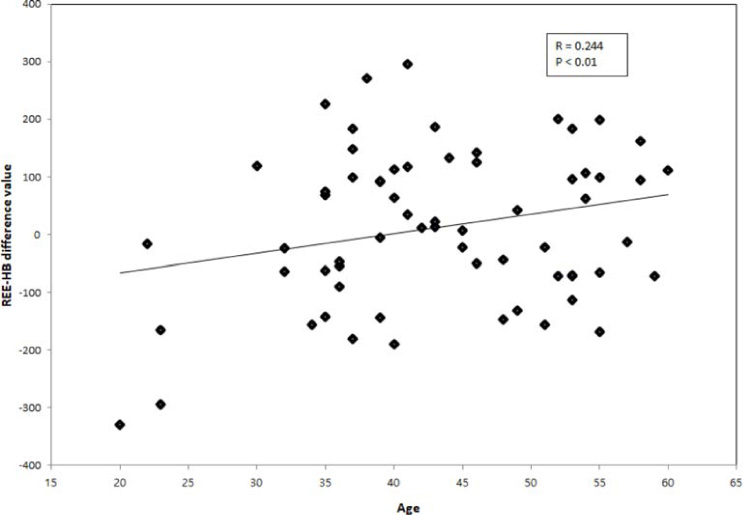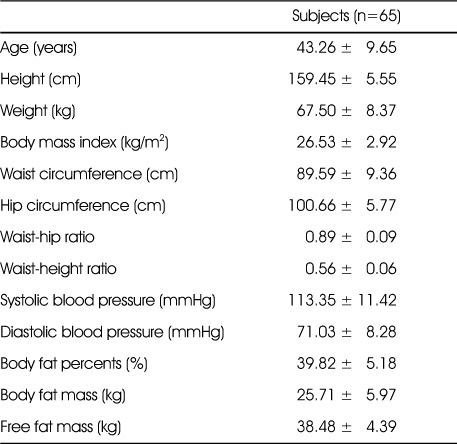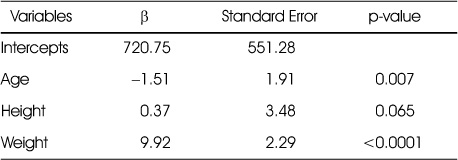References
1. WHO. Obesity and overweight. [internet] WHO; 2017. cited 18 Oct 2017. Available from:
http://www.who.int/.
2. Ministry of Health and Welfare, Korea Centers for Disease Control and Prevention. Korea Health Statistics 2016: Korea National Health and Nutrition Examination Survey (KNHANES VI-3) Sejong: Ministry of Health and Welfare; 2017.
3. Abdelaal M, Roux CW, Docherty NG. Morbidity and mortality associated with obesity. Ann Transl Med 2017;5(7):161.
4. Seo YW, Lee HJ, Yun KE, Park HS. Energy intake and resting energy expenditure of middle-aged obese Korean women. Korean J Obes 2009;18(1):31–37.
5. Poehlman ET. Exercise and its influence on resting energy metabolism in man. Med Sci Sports Exerc 1989;21(5):515–525.
6. Ravussin E, Harper IT, Rising R, Bogardus C. Energy expenditure by doubly labeled water: validation in lean and obese subjects. Am J Physiol 1991;261(3 Pt 1):E402–E409.
7. Johnston SL, Souter DM, Tolkamp BJ, Gordon IJ, Illius AW, Kyriazakis I, et al. Intake compensates for resting metabolic rate variation in female C57BL/6J mice fed high-fat diets. Obesity 2007;15(3):600–606.
8. Stewart CL, Goody CM, Branson R. Comparison of two systems of measuring energy expenditure. JPEN J Parenter Enteral Nutr 2005;29(3):212–217.
9. Frankenfield D, Roth-Yousey L, Compher C. Comparison of predictive equations for resting metabolic rate in healthy nonobese and obese adults: a systematic review. J Am Diet Assoc 2005;105(5):775–789.
10. Harris JA, Benedict FG. A biometric study of basal metabolism in man Washington: Carnegie institution of Washington; 1919.
11. Joint FAO/WHO/UNU. Energy and protein requirements: report of a joint FAO/WHO/UNU Expert Consultation. World Health Organ Tech Rep Ser 1985;724:201–206.
12. Owen OE. Resting metabolic requirements of men and women. Mayo Clin Proc 1988;63(5):503–510.
13. Mifflin MD, St Jeor ST, Hill LA, Scott BJ, Daugherty SA, Koh YO. A new predictive equation for resting energy expenditure in healthy individuals. Am J Clin Nutr 1990;51(2):241–247.
14. Henry CJ. Basal metabolic rate studies in humans: measurement and development of new equations. Public Health Nutr 2005;8(7A):1133–1152.
15. Son HR, Yeon SE, Cho JS, Kim EK. The measurements of the resting metabolic rate (RMR) and the accuracy of RMR predictive equations for Korean farmers. Korean J Community Nutr 2014;19(6):568–580.
16. Choi SH, Jo MW, Shin DS. Effects of the 8-week resistance exercise on body composition, serum hormone profiles and feeding patterns of obese females. Korean J Nutr 2004;37(10):888–898.
17. Lee JH. Treatment of obesity. Korean J Community Nutr 1990;29(3):307–320.
18. Yim JE, Kim YS, Choue R. Effects of age on changes of body composition through caloric restriction in overweight and obese women. J Nutr Health 2013;46(5):410–417.
19. Ministry of Health and Welfare and Korea Centers for Disease Control and Prevention. Korea Health Statistics 2014: Korea National Health and Nutrition Examination Survey [KNHANESVI-2] Sejong: Ministry of Health and Welfare; 2015.
20. Neeland IJ, Turer AT, Ayers CR, Powell-Wiley TM, Vega GL, Farzaneh-Far R, et al. Dysfunctional adiposity and the risk of prediabetes and type 2 diabetes in obese adults. JAMA 2012;308(11):1150–1159.
21. Derumeaux-Burel H, Meyer M, Morin L, Boirie Y. Prediction of resting energy expenditure in a large population of obese children. Am J Clin Nutr 2004;80(6):1544–1550.
22. Lee GH, Kim MH, Kim EK. Accuracy of predictive equations for resting metabolic rate in Korean college students. Korean J Community Nutr 2009;14(4):462–473.
23. Nam AY, Lee SY, Lee KJ, Park SB. The relationship between resting metabolic rate and cardiovascular risk factors in the obesity women. Korean J Obes 2008;17(2):73–81.
24. Park JA, Kim KJ, Yoon JS. A comparison of energy intake and energy expenditure in normal-weight and over-weight Korean adults. Korean J Community Nutr 2004;9(3):285–291.
25. Daly JM, Heymsfield SB, Head CA, Harvey LP, Nixon DW, Katzeff H, et al. Human energy requirements: overestimation by widely used prediction equation. Am J Clin Nutr 1985;42(6):1170–1174.
26. Ravussin E, Lillioja S, Knowler WC, Christin L, Freymond D, Abbott W, et al. Reduced rate of energy expenditure as a risk factor for body-weight gain. N Engl J Med 1988;318(8):467–472.
27. Weijs PJ. Validity of predictive equations for resting energy expenditure in US and Dutch overweight and obese class I and II adults aged 18-65y. Am J Clin Nutr 2008;88(4):959–970.
28. Bosy-Westphal A, Eichhorn C, Kutzner D, Illner K, Heller M, Muller MJ. The age-related decline in resting energy expenditure in human is due to the loss the loss of fat-free mass and to alteration in its metabolically active components. J Nutr 2003;133(7):2356–2362.
29. Kyle UG, Genton L, Hans D, Karsegard L, Solsman DO, Pichard C. Age-related differences in fat-free mass, skeletal muscle, body cell mass and fat mass between 18 and 94 years. Eur J Clin Nutr 2001;55(8):663.
30. Hong SG. Energy balance and obesity. J Korean Beriatr 2000;9(3):1–5.
31. Goran MI, Kaskoun MC, Johnson RK. Determinants of resting energy expenditure in young children. J Pediatr 1994;125(3):362–367.
32. Ravussin E, Lillioja S, Knower WC, Christin L, Freymond D, Abbott WG, et al. Reduced rate of energy expenditure as a risk factor for body weight gain. N Engl J Med 1988;318(8):467–472.
33. Napoli R, Horton ES. Present knowledge in nutrition 7th editionth ed. Washing USA: ILSI press; 1998.




